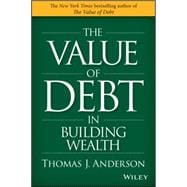For many adults under 40, 'debt' is a four-letter word—something that should be avoided but is all too often unavoidable. In The Value of Debt in Building Wealth, bestselling author Thomas J. Anderson encourages you to rethink that. You'll walk away from this book with an understanding of how you can use debt wisely to secure the financial future you envision for yourself and your family. Student loans, mortgages, lines of credit, and other forms of debt are all discussed in detail, with a focus on smart planning for those who are accumulating assets—and debt—now.
Should you rent or buy? How important is liquidity? What is good versus bad debt? How much debt should you have? What debt-to-income and debt-to-asset ratios should you aim for? Fixed debt or floating debt? What's the best way of saving for college and retirement? These are big questions that deserve thorough answers because the choices you make now could influence the course of your life. This thought-provoking book will open your eyes to savvy financial strategies for achieving your goals faster and with healthier bank accounts.
- Explore strategies for smart debt management, explained by one of the nation's top financial advisors
- Gain an understanding of investment basics and key financial concepts you'll need to achieve your long-term goals
- Understand the risks of having debt and the potential risks of being debt-free
- Make financial decisions now that will maximize your wealth, freedom, and opportunity later
This book is not about buying things you cannot afford. It is about liquidity, flexibility and optimizing your personal balance sheet. The Value of Debt in Building Wealth is full of ideas you can apply to your own situation—no matter what your current asset level. Read this book today and thank yourself later.








